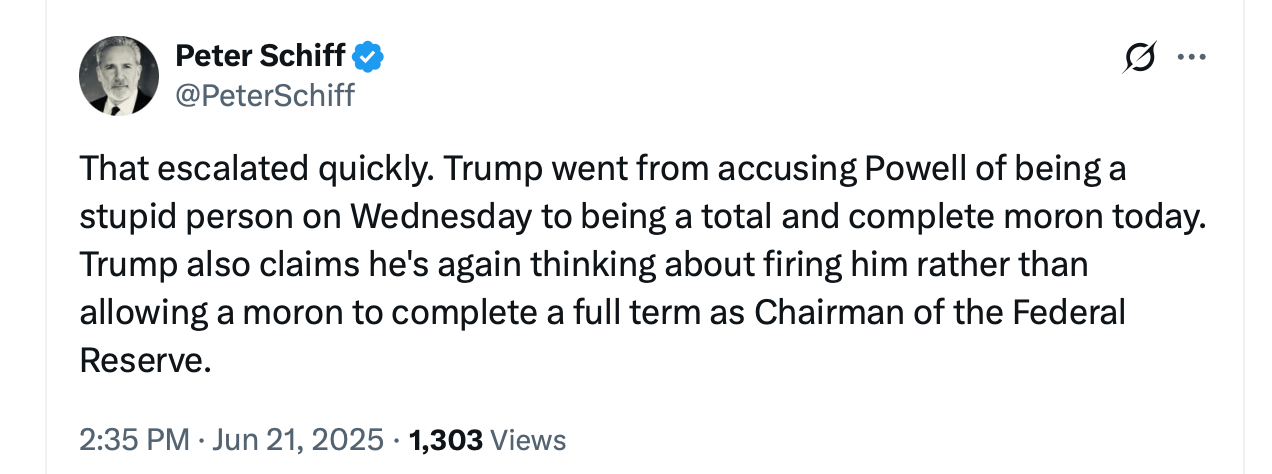President Donald Trump is once again targeting Federal Reserve Chair Jerome Powell, this time accusing him of costing the country trillions by refusing to lower interest rates. “He’s a dumb guy, and an obvious Trump Hater,” Trump said in a June statement posted on Truth Social alongside a global interest rate chart highlighting the Fed’s relatively high benchmark rate.
Earlier this week, before Trump fired off his latest comments, the U.S. Federal Reserve opted to keep interest rates right where they are. Despite three rate cuts in late 2024, the Fed’s federal funds rate has held steady between 4.25% and 4.50% since December 2024, placing the United States 35th globally in central bank rate rankings. Trump argued that a cut to 1%–2% would “save the United States of America up to $1 trillion dollars per year.”

While Trump’s rhetoric targeted Powell personally, Rep. Thomas Massie took a broader institutional view, arguing the Fed has effectively lost its independence due to unchecked congressional spending. “Dose of reality: Congress is spending, printing, and borrowing so much that the Fed has lost its ability to ‘set rates,’” Massie wrote on X.
Massie added:
Would be a great time to End the Fed.
In March 2025, Massie introduced H.R. 1846, the Federal Reserve Board Abolition Act, which seeks to dismantle the central bank entirely. The bill would repeal the Federal Reserve Act of 1913 and transfer the Fed’s assets to the Treasury.
Massie, economists, and analysts worldwide supporting this view assert that the central bank’s manipulation of interest rates distorts economic signals, fosters inflation, and centralizes financial power at the expense of the public. From a hard-money perspective, the Fed’s monetization of debt and rate targeting enable systemic moral hazard and erode the purchasing power of the U.S. dollar.
Though Powell has resisted recent political pressure, holding rates steady amid inflation concerns, critics argue the Fed is increasingly unable to reconcile its monetary goals with fiscal realities. Rising debt service costs tied to high rates underscore this tension.
From a classic Austrian economics view, the idea that a central authority should fiddle with the price of borrowing—otherwise known as the interest rate—is flat-out incompatible with a truly free and voluntary market. Forcing rates lower than what real savings would dictate breaks the natural connection between savers and investors, twisting the economy’s gears and paving the way for those all-too-familiar boom-bust spirals.
The nonstop drumbeat for lower rates, whether it’s coming from the Oval Office or Wall Street, shows just how hooked the system is on monetary manipulation instead of letting markets do their job. Trump’s all-in for cheaper loans. Massie’s on a mission to let money and markets breathe without central meddling. Each, in their own style, is pointing to the fallout of top-down monetary tinkering—a game of control that’s unraveling in plain sight.
Digging deeper, this school of thought argues that the very presence of the Fed masks and enables Congress’s addiction to overspending. Without the Fed there to whip up new money and buy the debt, lawmakers would run smack into the brick wall of economic reality. What we’re watching now—a tug-of-war between politicians chasing easy money and a central bank hesitant to crank the printing press—is the natural chaos of a system built on paper promises, monopoly control, and wishful thinking.
As many have argued, like the American economist, social theorist, and author Thomas Sowell, the fix isn’t a better version of this system—it’s pulling the plug altogether.
免责声明:本文章仅代表作者个人观点,不代表本平台的立场和观点。本文章仅供信息分享,不构成对任何人的任何投资建议。用户与作者之间的任何争议,与本平台无关。如网页中刊载的文章或图片涉及侵权,请提供相关的权利证明和身份证明发送邮件到support@aicoin.com,本平台相关工作人员将会进行核查。




